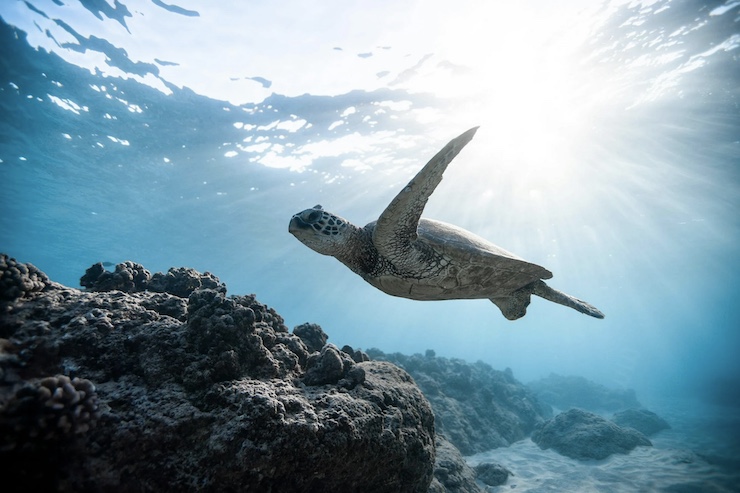
Scientists at the Okinawa Institute of Science and Technology (OIST), in collaboration with the Japanese telecommunications company NTT Communications, have begun deploying underwater drones to monitor the development of coral reefs subject to deterioration due to climate change. The remotely-piloted custom-built drones, the first to be used in Japan for the purpose of marine research, can dive hundreds of feet to collect eDNA from the reefs, identifying sources of contamination and alerting conservationists to the need for remedial action.
Scientists at the Okinawa Institute say their drones are far more efficient than traditional collection methods based on the use of scuba divers and snorkelers who are limited in the depth of their dives and scope of their sample collection. The drones can collect data on a regular basis across a wider area without the need for direct visual observation; they also yield results far more reliable than those gained through conventional field methods. Drone-based research is also faster, safer and cheaper, researchers say.
The site of the underwater drone collection effort is Kerama National Park, about 30 km west of Okinawa Island, which boasts some of the most transparent water in the Okinawa Archipelago, making it an ideal testing ground. A small fleet of drones is collecting seawater samples from 1 to 2 meters above the coral reefs at a depth of 20-80 meters. Some two dozen sampling sites in 6 different areas surrounding the picturesque Zamami Island have been selected, ensuring the broadest possible coverage of the reef’s biodiversity.
The next step in the research process is to analyze the collected samples to determine the precise genetic composition of the reef at various depths and water temperatures. Climate change and the warming of island waters has the potential to damage reefs in the area. So, too, does ocean acidification, which is increasing at alarming rates. Knowing precisely how different reef segments are responding to these pressures, and why, is critical to successful conservation efforts, researchers say.
After their initial collection effort last year, Institute scientists determined that several improvements in drone collection methods were needed. First, their custom-built drones were reconfigured to allow them to collect two kinds of samples during the same dive, maximizing the volume of collection and allowing for better comparative research. Second, the cable length between the controller and the drones was extended from 150 meters to 300 meters, allowing for deeper underwater sampling.
In addition, drones have been equipped with a swappable battery that allows for collection to proceed continuously throughout the day, without the need for periodic time-consuming recharging.
“My ideal survey would include the entire spectrum of the coral reef, from the shallow waters to the [deepest] mesophotic zones, and even the sandy depths. These [drones] provide an excellent method for conducting broader eDNA monitoring studies,” Prof Noriyuki Satoh at the Okinawa Institute says.
Satoh is now working with coral specialists at the University of the Ryukyus to further test his advanced drones at study sites near Sesoko Island, using his new and improved drones. Underwater UAVs are a “path-breaking innovation that could revolutionize coral reef research,” he argues.
Japan is hardly alone. Other coral reef observation projects using underwater drones are underway off the coast of Australia. A collaboration between the Australian Government’s Reef Trust and the Great Barrier Reef Foundation has resulted in the deployment of 11 separate collection projects that examine not just the health of deepwater reefs but also a range of marine populations, including fish and dolphin species, that interact with them. A separate project near Lord Howe island uses DJI Phantom 4 drones to conduct remote-imaging analyses of coral bleaching in shallow water reefs. These studies examine not just the effects of rising temperature but also rates of ocean acidification due to local sources of industrial pollution.
The Great Barrier Reef Foundation is also collaborating with Southern Cross University (SCU) on a drone project aimed at reversing damaging starfish infestations. Like the Okinawa project, the starfish project utilizes a custom-built UAV, this one known as RangerBot. The drone collects extensive data on the types and extent of starfish infestation of the reefs, But RangerBot one step forward, drawing on the data, it sweeps over the affected areas and eliminates the lethal starfish. According to researchers, the drone can “cleanse” 28 kms. of coral reef in a single day, compared to just 1 km of reef covered by a human diver.
|